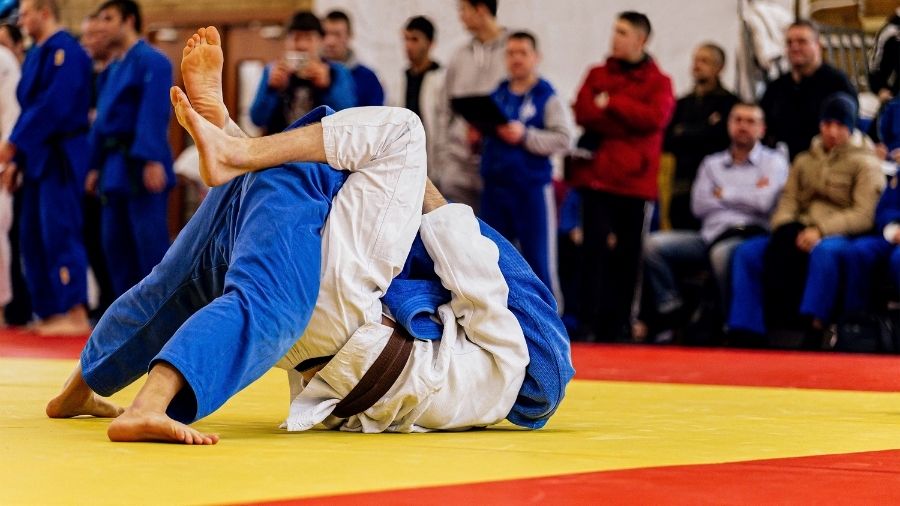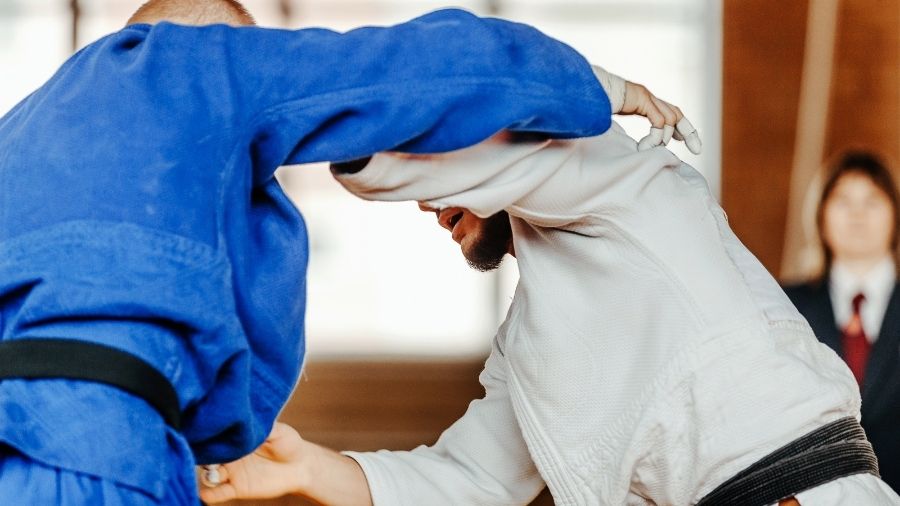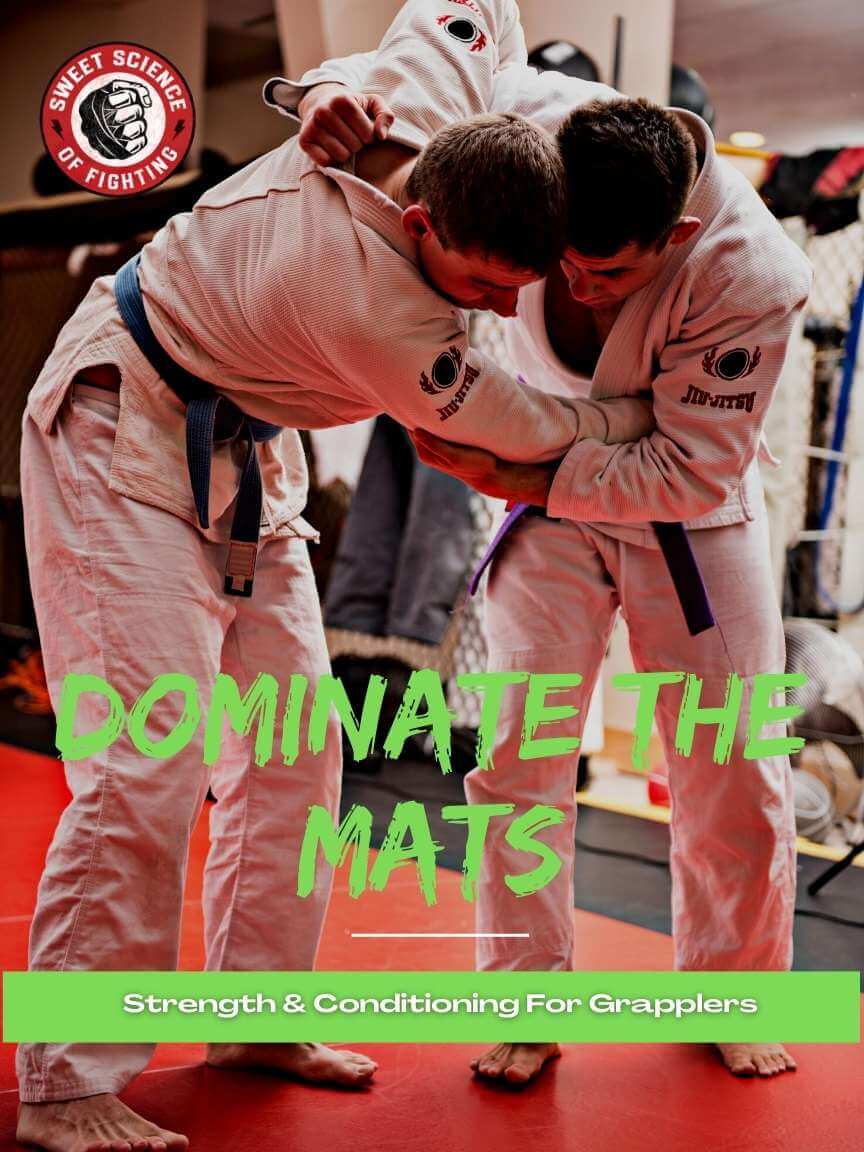Japanese Jujutsu and Brazilian jiu-jitsu are two separate martial sharing more than a few things. This is mainly because BJJ originates in Jujutsu, as the name clearly shows. But if you set Jujutsu against BJJ, what are all the significant differences? And which one is better and why?
Jujutsu is a combat system created and used in Japan from the 1500s and onwards for hand-to-hand fighting. It comprises grappling, ground fighting, and striking techniques in one system. BJJ has origins in Jujutsu, but it entirely focuses on unarmed ground fighting, and it has a well-developed sports element.
There is no striking within BJJ, and its students do not learn any military combat tactics. Does this mean Jujutsu is better for self-defense and street fighting, or is there more to the debate?
What Is Japanese Jujutsu?
Jujutsu is a martial art created by the Japanese military in the 15th century. It is also known as “Japanese Jiu-Jitsu” and “Jujitsu.”
It consists of grappling, striking, fighting on the ground, and “dirty” tactics put into one combat system to be used on the battlefield. Jujutsu was a mix of sumo and techniques from medieval Japanese martial arts in its initial form. Some of the early forms of Jujutsu were:
- Shinden Fudo-Ryu
- Tenshin Shoden Katori Shinto-ryu
- Takenouchi-Ryu
Jujutsu is a system designed for wars and lethal battles. With the advancement of warrior armor and protective equipment in Japan and the carrying of weapons at all times, striking techniques became less and less effective. This created a system focused on grappling and lethal ground fighting moves.
Samurai warriors would use Jujutsu to take the enemy down and incapacitate them with chokes and joint locks and/or kill them using a short weapon.
Combine these skills with striking and different tactics, and you get a versatile and highly effective martial art for real combat.
The name “jujutsu,” means “gentle art” and implies a person doesn’t have to be strong to execute effective techniques. Jujutsu uses leverage, body mechanics, and the opponent’s momentum to defeat them, rather than meeting force with force, a principle carried in martial arts like Judo, Sambo, and BJJ.
Jujutsu started to evolve at a high rate during the peaceful time of the Edo period. It became increasingly an unarmed self-defense system, moving away from its military purpose.
5 Step Blueprint To Build A BJJ Strength Workout To Demolish Your Opposition
Learn how to plan your strength training to maximize transfer to the mats.
What Is BJJ?
BJJ is a grappling martial art with its entire emphasis on ground fighting. It originates in Judo and Jujutsu, and its story began in the 1920s. At the time, a master called Matsuo Maeda traveled to Brazil to spread Judo.
Carlos and Helio Gracie became his students and would later use the skills learned as a base to create a new style. They moved the emphasis of Judo from powerful throws to ground fighting using chokes, joint locks, and positioning and implemented the guard, thus creating their version of jiu-jitsu.
Although it has been around since the 1920s, BJJ started to rise outside of Brazil with the birth of modern MMA fighting. In fact, most people associate BJJ with cage fighting, and this is no coincidence.
Back in the 90s, early UFC events were basically legal street fights without any time limits, weight classes, and barely any rules. It was a home of style vs. style matchups whose ultimate goal was determining which martial art was the most effective.
Thanks to Royce Gracie, who won 3 of the first 4 UFC tournaments, BJJ emerged as the best. Thanks to its success in MMA, the popularity of BJJ exploded in the 90s and 2000s.
Today, jiu-jitsu is the fastest growing combat sport and is passing in numbers of practitioners styles with much longer traditions in the West like Judo and wrestling.
Japanese Jujutsu vs. BJJ — What Are The Differences?

Jujutsu and BJJ share a lot of techniques and strategies and look alike, but at the same time, these two are separate martial arts, different in many aspects. Here is all you need to know:
History And Origins
The earliest records of Jujutsu go back to the Nara period. One of the oldest styles was “Shinden Fudo,” developed in 1130 AD. However, the form we know today emerged in the 15th century in Japan.
At the time, the military required a new combat system to enhance its soldiers’ hand-to-hand fighting abilities. They worked out that the most practical approach to kill the enemy was through grappling and ground fighting, so they created “jujutsu.”
BJJ is a grappling martial art created by the famous Gracie family in the 1920s in Brazil. The founders were brothers Carlos and Helio Gracie, both skilled judokas.
When they decided to develop their own style, the Gracie brothers took the Judo and Jujutsu skills they learned from Maeda and moved the focus to ground fighting while also implementing moves from catch wrestling and other styles.
Emphasis And Strategies
Jujutsu is a military combat style designed for war and self-defense. It is a brutal system where the emphasis is on killing or hurting the enemy as fast as possible. The main goal is to take the enemy down to the ground and finish them using various strangles, chokes, and joint locks.
As a system looking for a lethal result, it also includes eye gouging, groin strikes, weapons attacks, and many other pleasantries. It is much more aggressive and brutal than BJJ.
BJJ is a softer version of Jujutsu, focusing only on grappling. The striking in traditional BJJ is limited and used mainly to close the distance.
In modern sports, BJJ striking is completely absent. The emphasis is on learning how to grapple under competition rules and, to a lesser degree, on self-defense.
Techniques
Jujutsu students learn advanced grappling and ground fighting techniques and the basics of striking offense and defense.
They also must know how to use or defend against dirty moves. Some traditional schools also include weapon-based training. In addition to swords and staffs, students also learn how to handle contemporary weapons like sticks, bats, and knives.
BJJ is less versatile than Jujutsu on paper. The entire focus is on throws, trips, sweeps, and positioning on the ground before placing a submission.
There are hundreds of techniques and variations to master, and the list keeps growing as the art evolves rapidly thanks to its competition circuit.
Here are the main categories of BJJ techniques:
- Positions (full mount, back mount, side control, guard, half guard)
- Chokeholds- (rear-naked choke, triangle choke, anaconda choke, D’arce)
- Joint Locks- (armbar, leg lock, kimura)
- Various throws, trips, sweeps, and escapes.
Belt Ranks
Jujutsu belt ranking system:
- White
- Yellow
- Orange
- Green
- Blue
- Purple
- Brown
- Black
BJJ belt ranking system:
- White
- Blue
- Purple
- Brown
- Black
- Red and black belt (7th degree)
- Red and white belt (8th degree)
- Red belt (9th and 10th degree)
Equipment
Both traditional BJJ and Jujutsu are practiced with a kimono, also called a gi. It comprises a heavy cotton jacket, drawstring pants, and a colored belt denoting rank.
The BJJ gi is essential not only in aesthetics and tradition but also in the grappling itself, as it can be gripped and used in many offensive and defensive techniques.
For JJJ, you may also need MMA gloves or other types of protective equipment, but the type depends on the school and the type of practice.
BJJ has another hugely popular form, called no-gi, where practitioners train without a kimono. For this type of training, you will need a rash guard, BJJ shorts, and spats. As protective equipment, a mouthguard is strongly recommended.
Competitive Landscape
There is not much comparison between BJJ and JJJ regarding the competitive landscape. Jujutsu has no competitions as it’s trained mainly for self-defense and has no sports aspect.
BJJ on the other hand is thriving not least because it’s strongly sports-oriented. The competitions span all possible levels- from kids’ tournaments to professional-level events.
The competitive element takes away some of the real-life practicality but, at the same time, constantly pushes practitioners to evolve the style and come up with new and better ways to grapple, which makes BJJ a living and continually evolving martial art.
Japanese Jujutsu vs. BJJ For Self-Defense

Both BJJ and Jujutsu have pros and cons when it comes to self-defense. But as a more versatile system, Jujutsu has a slight edge in this aspect, at least theoretically.
In some way, Jujutsu is a total package for street fighting, and the skills you develop might help you get out of trouble and stay safe.
First, training includes theory lessons where students learn about history, first aid, and the body’s anatomy.
Next, they learn how to beat the enemy or even kill, using various grappling and ground fighting moves. Training also covers the basics of striking, which is missing from most BJJ academies.
Weapons training with and against contemporary weapons like knives, bats, and guns is also something Jujutsu is better than BJJ.
But if we put the number of skills learned aside, BJJ, in reality, is the better martial art because of the way it’s trained. Jujutsu, for the most part, is trained with a willing partner, and there is no sparring or competition.
This creates a very unrealistic way of training, which has been proven not to be transferrable to situations where the opponent is aggressively resisting and trying to hurt you.
In BJJ, sparring is daily, and you must learn how to apply every technique you learn against a resisting opponent.
Then, there is competition, which replicates, at least partially, the stress and intensity of real encounters. So, while BJJ has a more limited skillset, practitioners can actually use it.
There is a small portion of JJJ schools that realize the need for pressure testing and practice in a way that prepares you for real conflict.
If you are lucky enough to find one of those rare schools, you will likely learn much better self-defense skills than in the average BJJ academy.
Japanese Jujutsu vs. BJJ For MMA

BJJ has an edge in MMA fighting because it fits better within the sport’s rules. First of all, Jujutsu includes many techniques illegal in MMA and deals with weapons. Outside of that, the training methodology is also crucial.
If there is full contact sparring, some elements of any style may be transferred into MMA. If there isn’t sparring, the style is worthless for MMA.
BJJ plays a crucial role in modern mixed martial arts, which has been like that since day 1 when Royce Gracie ruled the sport. Since then, BJJ has evolved a lot, and its role has gotten even more prominent.
In this day and age, it is a crucial element of MMA for ground fighting, an element you can’t expect to succeed without. Every modern MMA fighter at the top level in the UFC must have at least basic BJJ skills in their arsenal.
According to stats, BJJ is in second place on the list of martial arts that have produced the most UFC champions, behind wrestling. Many great UFC fighters have had some background in BJJ, with the most famous ones being Charles Oliveira and Fabricio Werdum.
Japanese Jujutsu vs. BJJ — Who Would Win In A Street Fight?

The winner of the Jujutsu vs. BJJ matchup is based on many factors, like the place of the fight or if there are any weapons. But most of all it depends on the quality of the school.
Jujutsu emphasizes real-life combat scenarios and includes a broader range of weapons. It is much more versatile than BJJ because it has striking techniques, dirty tactics, and the emphasis is slightly different.
Modern BJJ practice is almost entirely oriented towards competition within a specific ruleset, which creates a lot of situations and habits that could be catastrophic in a real fight.
So, if you just read about the focus of the two martial arts, it’s natural to think JJJ is better at fighting.
But there is one big problem with it, which I already detailed in the self-defense paragraph, and it’s the unrealistic training.
Most schools don’t do sparring, and drilling is done with a cooperating partner who plays the role of a dummy. And unsurprisingly, practitioners who have only trained this way rarely can actually fight.
A BJJ practitioner with a couple of years of training and a few competitions under his belt will be well equipped to deal with an aggressive opponent, even with their sports-oriented skills, lacking any striking.
Again, If the jujutsu academy does train realistically, like in the video of Kobukai jiu-jitsu above, things can look very different.
Jujutsu vs. BJJ — Which One Is Better For You?
The answer to this question is based on many factors. The most important one is why you want to practice martial arts, your age, and what you want to achieve. Here is a final look at these arts that might help you make the right choice.
BJJ should be your choice if you want to learn self-defense tactics, compete in matches, or switch over to MMA later in the future. It is also a much safer option because it doesn’t include striking, so people choose BJJ over other martial arts, not just Jujutsu.
Despite the lack of striking, it is still effective enough for street fighting, and each technique you learn in training works in real life as well. And unlike jiu-jitsu, BJJ students spar daily, which, apart from providing a lot of fun, is the best way to learn how to fight.
Jujutsu should be your choice if your priority is learning self-defense skills. Techniques you learn, and skills you develop in training work well in real situations and can get you out of trouble. But remember, this statement is only valid in the right academy, which is sadly hard to find.
Dominate The Mats And Manhandle The Opposition
3 different strength training programs turn you into a monster on the mats. Prepare yourself for the mats and for competition while prioritizing your BJJ training.



